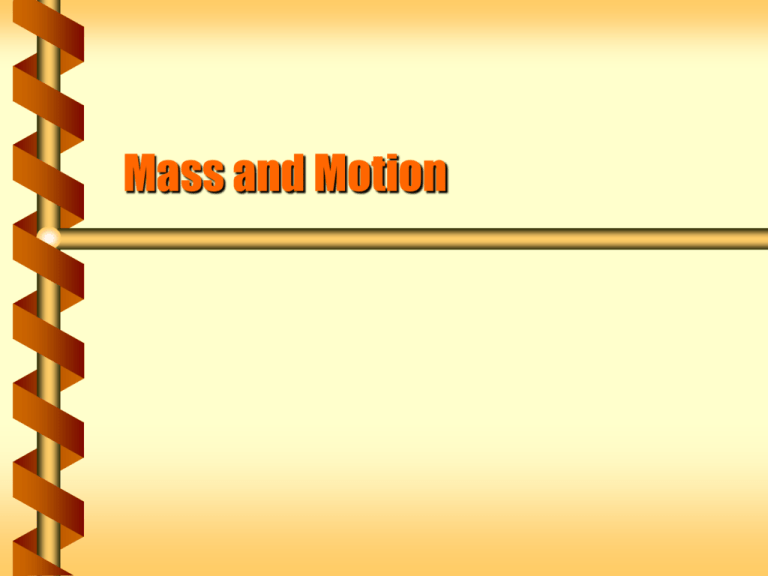Mass and Motion
advertisement

Mass and Motion Mass Matter has substance. • Solids, liquids or gases • Subatomic particles • Planets and stars Weight is not mass, but mass can have weight. Mass measures the amount of matter in an object. Mass Units Mass is measured in kilograms. • 1 kg = 1000 g • 1 atomic mass unit (about the mass of one hydrogen atom) = 1.66 x 10-27 kg © R. Rathe, NIST Pounds measure weight (a force) not mass. Force and Acceleration With force there is acceleration. The amount of acceleration depends on the mass. Mass is a scalar. • Mass times a vector gives another vector. • The direction of the force and acceleration are the same. F a m F ma Force Units Force is mass times acceleration. The dimensions of force are M(L/T2). In SI units a newton (N) = 1 kg m / s2. Second Law: Law of Acceleration 2 The change in motion is proportional to the net force and the change is made in the same direction as the net force. Net force gives rise to acceleration. Force = mass x acceleration (Newton’s second law). Initial velocity Final velocity: changed by the force Rocket: has mass Force: becomes acceleration Vector Force A 1000 kg satellite in space is moving at 5.0 km/s when a rocket fires with a thrust of 5.0 x 103 N at 60° to the direction of motion. The rocket fires for 1 minute. Where does it move after firing? F = 5000 N q = 60 x Identify the quantities in the problem: • • • • Mass, m = 1000 kg Initial velocity, v0 = 5 x 103 m/s Force, F = 5 x 103 N at 60° Time, t = 1 min = 60 s Force and velocity are vectors • Pick x in the direction of initial motion: vx = v0 . • Fx = F cosq • Fy = F sinq Change in Velocity A 1000 kg satellite in space is moving at 5.0 km/s when a rocket fires with a thrust of 5.0 x 103 N at 60° to the direction of motion. The rocket fires for 1 minute. Where does it move after firing? v The force gives acceleration. • ax = Fx /m = (F/m) cosq • ay = Fy /m = (F/m) sinq The change in velocity is due to this acceleration. • vx = v0 + ax Dt • = v0 + (F t / m) cosq • vy = ay Dt = (F t / m) sinq The final velocity is • vx = 5200 m/s = 5.2 km/s • vy = 260 m/s = 0.26 km/s. v0 next


